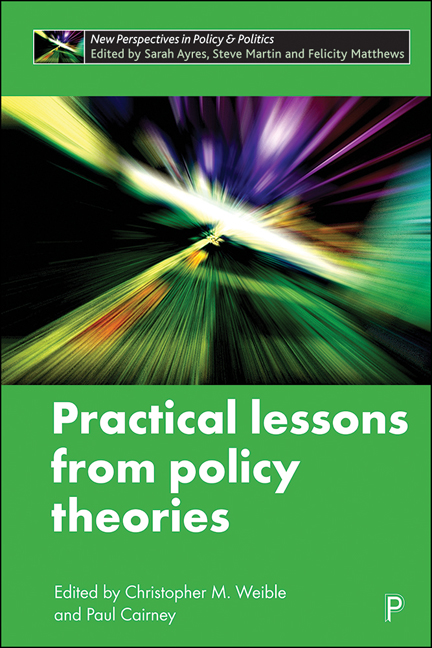Book contents
- Frontmatter
- Contents
- List of figures and tables
- Notes on contributors
- one Purposes and paths in drawing practical lessons from policy theories
- two Three habits of successful policy entrepreneurs
- three Narratives as tools for influencing policy change
- four Using cultural theory to navigate the policy process
- five The lessons of policy learning: types, triggers, hindrances and pathologies
- six Practical prescriptions for governing fragmented governments
- seven Drawing practical lessons from punctuated equilibrium theory
- eight Policy design and the added-value of the institutional analysis development framework
- nine Why advocacy coalitions matter and practical insights about them
- ten Reflections and resolutions in drawing practical lessons from policy theories
- Index
seven - Drawing practical lessons from punctuated equilibrium theory
Published online by Cambridge University Press: 05 January 2022
- Frontmatter
- Contents
- List of figures and tables
- Notes on contributors
- one Purposes and paths in drawing practical lessons from policy theories
- two Three habits of successful policy entrepreneurs
- three Narratives as tools for influencing policy change
- four Using cultural theory to navigate the policy process
- five The lessons of policy learning: types, triggers, hindrances and pathologies
- six Practical prescriptions for governing fragmented governments
- seven Drawing practical lessons from punctuated equilibrium theory
- eight Policy design and the added-value of the institutional analysis development framework
- nine Why advocacy coalitions matter and practical insights about them
- ten Reflections and resolutions in drawing practical lessons from policy theories
- Index
Summary
Introduction
Promoting informed decision-making is a recurring theme in improving the efficacy and responsiveness of government. Consistent with this theme is the assumption that decision-makers face an information deficit – that if decision-makers simply had access to the right knowledge that they would make better decisions. There exists an overarching normative consensus that more information in the policy process is generally good, but there are limits to how much decision-makers can process. Scholars of public policy, and particularly agenda setting, have tended to find that the central problem of policymaking is not a deficit of information, but instead, an oversupply of information. Very often, then, the central problem confronting decision-making is prioritising among this information. Information-processing, specifically attention, is seen as the driver of policy change in theories of agenda-setting such as multiple streams (see Cairney, this issue) and particularly so in punctuated equilibrium theory (PET). PET scholars have long understood that policy and institutional design are critical to information-processing (Baumgartner and Jones, 1993). This chapter represents a guide for scholars wishing to bridge the divide between PET theory and the practice of institutional design.
The engine of information processing in policy systems are subgovernments. Subgovernments are defined collections of policy actors in government, and around government, who develop and make policy within substantively specific issues. Usually, these subgovernments will contain an authoritative body (for example, a city council or congressional committee), an administrative unit for implementing policy (for example, the ministry of transportation or the police department), and supportive constellations of those interested in the policy issue (for example, Greenpeace or the Chamber of Commerce). Finally, subgovernments may also operate within specific policy areas (for example, energy policy), but be delineated along functionally differentiated lines (for example, regulate energy or subsidise the industry).
It is commonly understood that more information in the policy process is generally a good thing, but building the capacity to process that information creates classic challenges of delegation, coordination, accountability and organisation. Subgovernments have their own information processing limitations, irrespective of how narrow their focus. Information processing limitations and oversight challenges lead to inadequate problem redress even on the parts of subgovernments. For governments, centralisation of decision-making is a natural impulse to contend with the daunting twin challenges of corralling myriad subgovernments coupled with still suboptimal outcomes.
- Type
- Chapter
- Information
- Practical Lessons from Policy Theories , pp. 131 - 150Publisher: Bristol University PressPrint publication year: 2021



